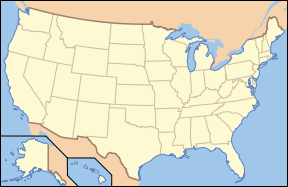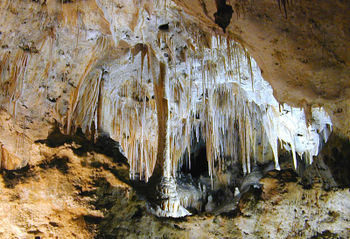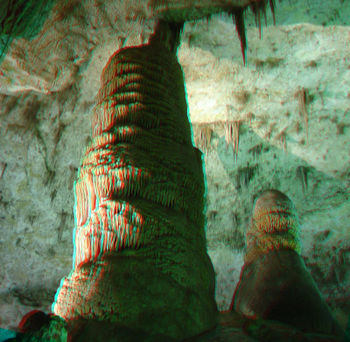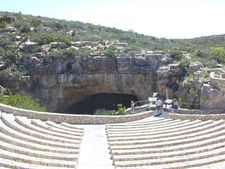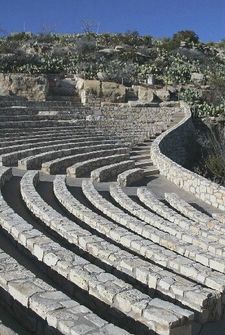Carlsbad Caverns National Park
2007 Schools Wikipedia Selection. Related subjects: North American Geography
| Carlsbad Caverns National Park | |
|---|---|
| IUCN Category II ( National Park) | |
| Location: | New Mexico, USA |
| Nearest city: | Carlsbad, NM |
| Coordinates: | |
| Area: | 46,766.45 acres (46,427.26 federal) 189.26 km² |
| Established: | May 14, 1930 |
| Visitation: | 419,599 (in 2004) |
| Governing body: | National Park Service |
Carlsbad Caverns National Park is a United States National Park located in the Guadalupe Mountains of the southeastern corner of New Mexico ( Eddy County). It was established to preserve Carlsbad Cavern and numerous other caves within a Permian-age fossil reef. The park contains 83 separate caves, including Lechuguilla Cave, the nation's deepest and third longest limestone cave—1,604 feet (489 m). Carlsbad Cavern, with one of the world's largest underground chambers and countless formations, is highly accessible, with both self-guided and a variety of ranger-guided tours offered year round. Visitors can hike into the interior rooms on their own via the natural entrance, or take an elevator (the exit for everyone) directly down into the centre of the public cave area.
Carlsbad was first designated a National Monument on 25 October 1923. Congress upgraded the monument to a national park on 14 May 1930. Carlsbad Caverns was also designated a World Heritage Site on 6 December 1995. Approximately two thirds of the park has also been set aside as a wilderness area, helping to ensure no future changes will be made to the habitat.
The park is open year-round except Christmas Day, but the majority of park visitors come during the months of June, July and August, and weekends and holidays. The month with the least visitors is January, and peak visitation typically occurs on the weekends following Memorial Day and the 4th of July. The park entrance is located on US Highway 62/180 approximately 18 miles (29 km) southwest of Carlsbad, New Mexico.
Geology
The story of the creation of Carlsbad Cavern begins 250 million years ago with the creation of a 400 mile (600 km) long reef in an inland sea that covered this region(Noah's World-wide flood). This horseshoe shaped reef formed from the remains of sponges, algae and seashells and from calcite that precipitated directly from the water. Cracks developed in the reef as it grew seaward. Eventually the sea evaporated and the reef was buried under deposits of salts and gypsum.
Then, a few million years ago, uplift and erosion of the area began to uncover the buried rock reef. Rainwater, made slightly acidic from the air and soil, seeped down into the cracks in the reef, slowly dissolving the limestone and beginning the process that would form large underground chambers. At the same time, hydrogen sulfide gas was migrating upward from vast oil and gas deposits beneath the ancient reef. This gas dissolved in the percolating ground water to form sulfuric acid. The added power of this corrosive substance explains the size of the passageways. The exposed reef became part of the Guadalupe Mountains and the underground chambers became the wonder of Carlsbad Cavern.
The decoration of Carlsbad Cavern with stalactites, stalagmites and an incredible variety of other formations began more than 500,000 years ago after much of the cavern had been carved out. It happened slowly, drop by drop, at a time when a wetter, cooler climate prevailed. The creation of each formation depended on water that dripped or seeped down into the limestone bedrock and into the cave. As a raindrop fell to the ground and percolated downward, it absorbed carbon dioxide gas from the air and soil, and a weak acid was formed. As it continued to move downward the drop dissolved a little limestone, absorbing a bit of the basic ingredient needed to build most cave formations -- the mineral calcite.
Once the drop finally emerged in the cave, the carbon dioxide escaped into the cave air. No longer able to hold the dissolved calcite, the drop deposited its tiny mineral load as a crystal of calcite. Billions and billions of drops later, thousands of cave formations had taken shape. Where water dripped slowly from the ceiling, soda straws and larger stalactites appeared. Water falling on the floor created stalagmites. Sometimes a stalactite and stalagmite joined, forming a column.
Draperies were hung where water ran down a slanted ceiling. Water flowing over the surface of a wall or floor deposited layers of calcite called flowstone. Cave pearls, lily pads and rimstone dams appeared where pools of water or streams occurred in the cave. Like oyster pearls, cave pearls were made as layer upon layer of calcite built up around a grain of sand or other tiny object. Lily pad-shapes formed on the surface of pools, while dams formed where water flowed slowly on the floor. Another type of cave formation that decorated cave walls and even other formations are popcorn-shapes, which may have formed when water evaporated and left behind calcite deposits.
Some of the more unusual formations to occur in Carlsbad Cavern are helictites, which grow seemingly without regard to gravity, their twisting shapes governed by crystal shapes, impurities and the force of water under pressure. Other rare formations are those composed not of calcite, but of aragonite, a mineral chemically identical to calcite but with a different crystal structure. These formations tend to be small, delicate and needle-like.
- For detail on the area's geology, see Delaware Basin
Bats
Carlsbad Cavern is a sanctuary for about one million Mexican Free-tailed Bats. During the day the bats crowd together on the ceiling of Bat Cave, a passageway near the natural entrance of Carlsbad Cavern. In their darkened home they are seen only by scientific researchers. At nightfall, however, the bats leave the cave in gigantic swarms. Silhouetted against the night sky like a dark, swift-moving cloud, the bats make their most dramatic display.
The Bat Cave serves as a warm weather home, as a daytime refuge, and perhaps most importantly, as a maternity roost, for Mexican Freetail Bats. The bats migrate from Mexico to Carlsbad Cavern each year to give birth and raise their young. Under cover of darkness, away from predators or disturbances, the young are born in June.
As many as six other types of bats roost in the Cavern.
The spectacular night flight of the Mexican Freetail begins with a few bats fluttering out of the natural entrance of Carlsbad Cavern. Then, in a matter of minutes, a thick whirlwind of bats spirals out of the cave up into the darkening night sky. The exodus can last 20 minutes or as long as 2.5 hours. Once out of the cave the undulating mass of thousands of bats flies, in serpentine fashion, towards the southeast to feed in the Pecos and Black River valleys. Once there, they begin gorging themselves on moths and other night-flying insects. Using echolocation, each bat may catch and eat several stomachfuls of insects in a single night. With the coming of dawn, the bats begin flying back to the cave individually or in small groups. They re-enter the cave in a fashion almost as remarkable as their departure. Each bat positions itself high above the cave entrance. It then folds its wings close to its body, and plummets like a hailstone into the blackness of Carlsbad Cavern, making a strange buzzing sound as it does. One by one, the bats return to the safety of the Bat Cave, where they sleep until reemerging in the dusk of the next day.
History
Several hundred years ago prehistoric Native Americans may have ventured into the Cavern seeking shelter. Their cave drawings still remain near the entrance. Much later, in the 19th century, U.S. settlers discovered the cavern, drawn to it by the spectacle of hundreds of thousands of bats rising up out of the natural entrance in the evening. Shortly thereafter, a local businessman named Abijah Long filed a claim to mine the huge deposits of bat guano in the cave and sell it as fertilizer. One of Long's associates, a cowboy named Jim White, became fascinated by the cave and spent hour after hour exploring it. White was eager to show the many natural wonders of this extraordinary place to others, but few persons believed his improbable tales of a huge underground wilderness full of unusual cave formations. It took photographs to convince skeptics that Carlsbad Caverns was everything it was said to be and more.
White explored many of the rooms and gave them their names, including the Big Room, New Mexico Room, King's Palace, Queen's Chamber, Papoose Room, and Green Lake Room. He also named many of the cave's more prominent formations, such as the Totem Pole, Witch's Finger, Giant Dome, Bottomless Pit, Fairyland, Iceberg Rock, Temple of the Sun, and Rock of Ages.
Black and white pictures taken by Ray V. Davis, who accompanied White on a cave trip, were displayed in the town of Carlsbad in 1915. They created a sensation. People suddenly clamored to see the marvelous cave for themselves. White took them on tours that began with an unceremonious 170 foot descent in a bucket once used to haul bat guano from the cave.
Word of the cave spread, finally reaching Washington, D.C. Again, there were nonbelievers, but in 1923 the U.S. Department of the Interior sent General Land Office mineral inspector Robert Holley to investigate and see whether Carlsbad Cavern was truly an outstanding natural scenic wonder. Originally a skeptic, Holly, after five weeks of exploration with his expedition, wrote in his final report:
-
- "...I am wholly conscious of the feebleness of my efforts to convey in the deep conflicting emotions, the feeling of fear and awe, and the desire for an inspired understanding of the Divine Creator's work which presents to the human eye such a complex aggregate of natural wonders...."
Later that year on October 25, 1923 Carlsbad Cavern was proclaimed a national monument. White, who was to continue his cave explorations for most of his lifetime, became its first chief park guide in 1925. Five years later Carlsbad Caverns National Park was created to protect the cave. Through illustrated articles published in magazines such as National Geographic—in 1924 and 1925 (based on the expedition of geologist Rock Lee)—and by word of mouth, Carlsbad Cavern became one of the world's most celebrated caves. Since its establishment, the park has been expanded and today includes 189 km² (46,766 acres) and more than 80 other smaller caves.
Carlsbad, the town, and, thus, Carlsbad Caverns National Park, supposedly take their name from Jake Schauer, Czech Republic ( Carlsbad —literally, Charles' Baths, in German).
Rooms
- Balloon Ballroom - located in the ceiling above the main entrance corridor, this small room was first accessed by tying a rope to a bunch of balloons and floating them up into the passage.
- Bell Cord Room - named for a long, narrow stalactite coming through a hole in the ceiling, resembling the rope coming through a church steeple to ring the bell. This room is located at the end of the Left Hand Tunnel.
- Bifrost Room - discovered in 1982, it is located in the ceiling above Lake of the Clouds. Its name refers to a Norse myth about a world in the sky that was accessed from Earth by a rainbow. The room was given this name because of its location above the Lake of the Clouds and its colorful oxide-stained formations.
- Big Room or The Hall of the Giants - the largest chamber in Carlsbad Caverns, its floor space equals roughly 14 football fields.
- Green Lake Room - the uppermost of the "Scenic Rooms", it is named for a deep, malachite-colored pool in the corner of the room. In the 1940s, when the military was testing the feasibility of Carlsbad Cavern as an emergency fallout shelter, the Green Lake was used to look for ripples caused by a nuclear bomb test many miles away. None appeared.
- Guadalupe Room - discovered by a park ranger in 1966, this is the second largest room in Carlsbad Caverns. It is known for its dense collection of "soda straw" stalactites.
- Hall of the White Giant - a large chamber containing a large, white stalagmite. Rangers regularly lead special tours to this location.
- King's Palace - the first of four chambers in a wing known as the "scenic rooms", it is named for a large castle-like formation in the centre of the room.
- Lake of the Clouds - the lowest known point in the cave. It is located in a side passage off the Left Hand Tunnel. It is named for its large lake containing globular, cloud-like rock formations.
- Left Hand Tunnel - a long, straight passage marked by deep fissures in the floor. These fissures are not known to lead anywhere. The Left Hand Tunnel leads to the Lake of the Clouds and the Bell Cord Room.
- Mystery Room - a small room located in Lower Cave.
- New Mexico Room - located adjacent to the Queen's Chamber and accessed by means of a short slope.
- Papoose Room - located between the King's Palace and Queen's Chamber.
- Queen's Chamber - widely regarded as the most beautiful and scenic area of the cave. Jim White's lantern went out in this chamber while exploring and was in the dark for over a half hour.
- Spirit World - Located in the ceiling of the Big Room, this area is filled with white stalagmites that resembled angels to the room's discoverers.
- Talcum Passage - a room located in Lower Cave where the floor is coated with gypsum dust.
- The Rookery - one of the larger rooms in Lower Cave.
Recent exploration
Carlsbad Cavern attracts many men and women who are eager to shed light on some of its mysteries. Teams of cavers well versed in safe exploration techniques continue to discover new portions of the cave. Their finds in recent years include the Guadalupe Room, Carlsbad Cavern's second largest room, in 1966; the exceptionally colorful and much decorated Bifrost Room, in 1982; the Chocolate High, one of the most recent discoveries, in 1993.
In 1985 a very distinctive method of exploration was invented. In a dome area 250' above the Big Room floor not far from the Bottomless Pit a stalagmite leaned out. Using a balsa wood loop with helium-filled balloons attached, the explorers--after several tries over several years--floated a light weight cord that snagged the target stalagmite. Once the light weight cord was in position up, over, and back to the ground, a climbing rope was pulled into position, and the explorers ascended into what they named The Spirit World.
Lechuguilla Cave, another cave in the park discovered in 1986, is the focus of much current cave exploration at the park. It has been mapped to a depth of 489 m, making it the deepest limestone cave in the U.S. It is not accessible to the general public, and its exact location is kept secret in an attempt to preserve the cave in its most undisturbed state.
The Bottomless Pit was originally said to have no bottom. Stones were tossed into it, but no sound of the stones striking the bottom were heard. Later exploration revealed that the bottom was about 300 yards deep and covered with soft dirt. The stones made no sound when they struck the bottom because they were lodged in the soft dirt.
Scientific discoveries by speleologists, or cave scientists, are expanding our knowledge of Carlsbad Cavern in other ways. Research is answering some of the questions about the complex creation of Carlsbad Cavern, about the unfamiliar world of bats and other members of the cave community, and about the effects of man's activities on the cave.
